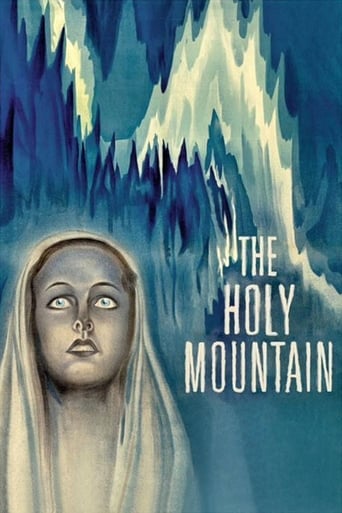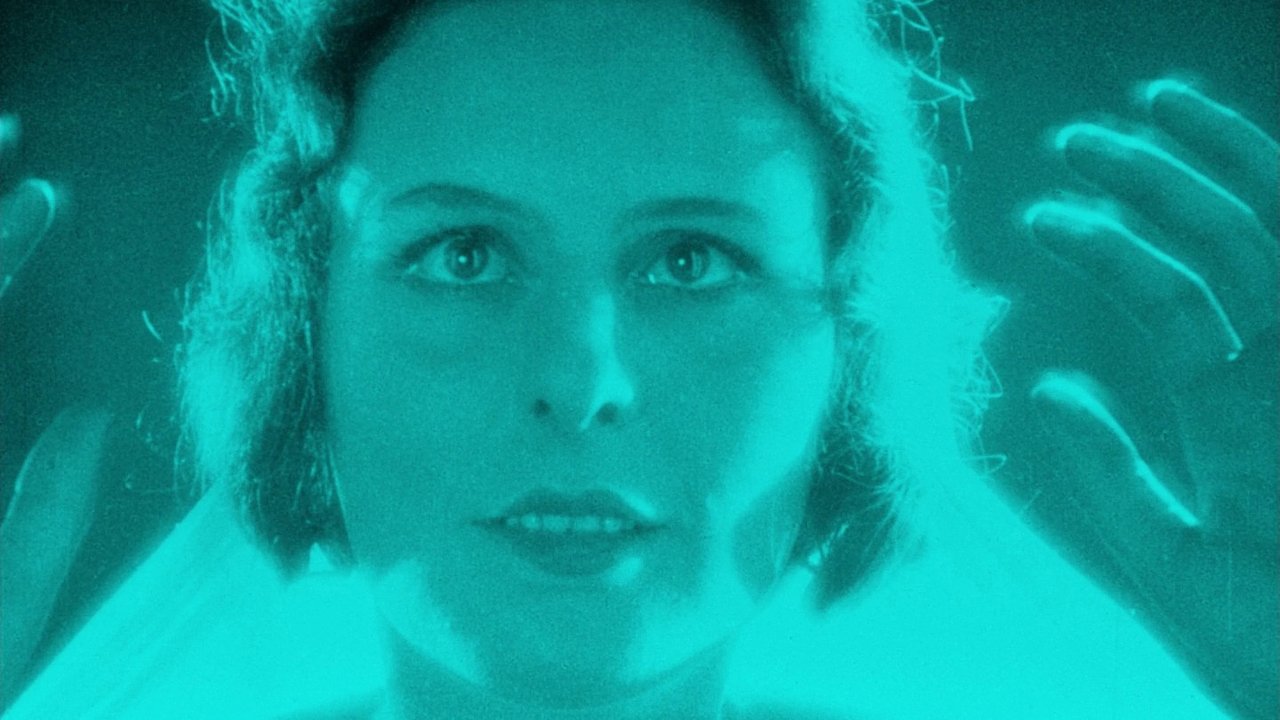Horst in Translation (filmreviews@web.de)
"Der heilige Berg" or "The Holy Mountain" is a German silent film in black-and-white from the year 1926, so this one has its 90th anniversary this year already. It was written and directed by German filmmaker Arnold Fanck, a man who is mostly known for his mountain-themed films from the first half of the 20th century. The cast includes Ernst Petersen, a regular in Fanck's films, Leni Riefenstahl before her days as a propaganda filmmaker, and Luis Trenker, a famous mountain climber who turned to acting. The film runs for 100 minutes approximately, but I have to say that in terms of the story and the plot 50 minutes would have been more than enough. The story is not the greatest strength here about a pair of climbers and a woman who stands between them, but this is a common problem with Fanck's works. However, his biggest strength also keeps this film from being a really boring or disastrous watch. Visually, it is way ahead of its time, no doubt about it. The snowy landscapes are a joy to watch and I can see why this film still appeals to people today. There are some genuinely beautiful shots in here. However, this is not enough to make up for the deficits in terms of story-telling and my overall verdict for this movie from between World Wars I and II is a negative one. Thumbs down and I do not recommend the watch. The good thing for foreign audiences is that this film also exists with English intertitles if they really want to see it. But I cannot really support this decision.
FerdinandVonGalitzien
After a scene in Herr Wilhelm Prager's "Wege Zu Kraft Und Schönheit" (1925), "Der Heiliger Berg" was the first film of Dame Leni Riefenstahl as a lead actress. It was a film written exclusively for her by Herr Arnold Fanck according to Dame Riefenstahl memoirs, a book that includes other partial and conceited memories
from a time in the mid-20s when she was a famous dancer.The film includes a prologue in where we can see Dame Riefenstahl dancing or something like that, well
knowing that Germans, even the aristocrats, had a particular sense of rhythm more suited to military parades with plenty of goose steps, you will be able to understand the reason why Dame Riefenstahl was a famous dancer during the Weimar era.Herr Arnold Fanck, as a director was noted as the creator of one of the most successful and peculiar German film genres: the mountain films. (Actually, Herr Fanck was a famous director at that time thanks to mountain documentaries; "Der Heilige Berg" was his first film that includes a plot). In these films nature and its consequences are always centred on the lead character of these beautiful films with their superb cinematography and vigorous editing. Men and women have to fight against the savage elements in what it is finally an unequal and difficult battle. That's the most important aspect of the film, those incredible beautiful nature shots because Dame Riefenstahl as a dancer/actress or Herr Trenker (the male lead actor) as an actor are not very impressive, or
in the strict German sense, they are depressive."Der Heilige Berg" shows different nature's conditions and contradictions. In the first part of the film, our heroine, Diotima the dancer, is immersed in bucolic, idealized and calm mountain landscapes full of flowers, shepherds, people skiing and all that kind of strange things. In the second part of the film the beautiful mountain landscapes will transform to a dangerous and inaccessible place in which the snowfalls and avalanches will prevent the rescue of two of Diotima's lovers who are isolated at the mountaintops. In many occasions during the film, some scenes are prolonged unnecessarily due to the excessive emphasis on mountain scenery that Herr Fanck wanted; duplicate shots diminish the film's action in a Herr Trenker oeuvre whose inner intention is to be a tribute to nature and the Teutonic mountains.And now, if you'll allow me, I must temporarily take my leave because this German Count must to climb the aristocratic ladder.Herr Graf Ferdinand Von Galitzien http://ferdinandvongalitzien.blogspot.com/
Bill-1035
A pioneering 'berg' film from the silent days of German cinema starring Leni Riefenstahl, later made famous or infamous as the documenter of Nazi Germany in 'Triumph of the Will' (the 34 Nuremburg rally) and 'Olympiad' (the 36 Olympics). This was her first acting film and she does a lot of dancing (quite good) and some over-acting, (quite bad) waving her arms in the air and rolling her eyes, taking her cue from Mae Marsh, no doubt.The eternal triangle story is so simple I still can't believe Fanck took 1¾ hours to tell it. However to give him his due a lot of the film is taken up by scenery shots some of which are quite spectacular. A downhill ski race is also a feature although Fanck clearly plays fast and loose with times and locations so don't expect anything to make a whole lot of sense during this section. If they had had continuity girls at that time this one would have been looking for another job in real short order.The climax of the film comes when 'The Mountaineer' sees his fiancée (Riefenstahl) being groped by some man. He is furious but in true public school style attempts to sublimate his anger in a daring mountain climb much like Riefenstahl sublimated her excessive emotion in a dance earlier in the film. (Quite clearly at the time violent exercise and a cold shower in the morning was thought to be a cure for everything.) Half way up they have stopped for a rest on a narrow ledge when a chance remark by Vigo, the companion, makes 'the mountaineer; realise that it was the guy he is now roped to who was groping his fiancée. He is so furious that forgetting the floor space is somewhat restricted he makes a threatening gesture towards Vigo who instinctively steps back and
..whoops! (An earlier comment on this site stated that he planned to murder Vigo but Fanck makes it clear that he did not, it was an accident.) An interesting comparison can be made between Fanck's movie and the recent mountaineering drama documentary 'Touching the Void' in which fact virtually duplicates the fiction of 'Holy Mountain'. Watching the two in close proximity is very illuminating for the ethos of both films. I think the earlier movie has the edge when it comes to cinematography despite the fact that fixed camera position is the rule though I expect in some of the locations even actors' movements must have been a problem. The shooting of the film itself was plagued by weather problems, ice kept melting, snow turned to slush and the whole project was nearly thrown out by UFA. This is not a great movie but, especially with the comparison with 'Touching the Void', it is a fascinating movie from a historical perspective as well as worth watching in its own right if you are a fan of silent movies.
F Gwynplaine MacIntyre
German filmmaker Arnold Fanck single-handedly invented an entire movie genre: the mountain film. This refers not to mountain-climbing movies in general, but to a specific type of movie in an Alpine setting. A 'mountain film' depicts the experiences of an athletic young Aryan man, high in the mountains, where he communes with nature and meets a beautiful blonde woman who somehow embodies both the Aryan physical ideal and the German countryside itself. Their relationship is erotic, yet has semi-mystical aspects bordering on a religious epiphany. The man learns much about himself. Sometimes (as happens here in 'Der Heilige Berg') a mountain film has two male protagonists, both athletic, who develop a rivalry over the blonde fraulein.Although Fanck invented and embodied the mountain-film genre, in the same way that Alfred Hitchcock defined the suspense film and Busby Berkeley defined the Depression-era musical, Fanck was by no means the only 'mountain-film' director. Movies in this genre have been made by directors as disparate as Hitchcock ('The Mountain Eagle') and Fred Zinnemann ('Five Days One Summer').'Der Heilige Berg' ('The Holy Mountain') features Louis Trenker as Karl, a downhill skier who loves a beautiful dancer named Diotina. (Played by Leni Riefenstahl, who is so sexy here that I can well believe that Hitler had the hots for her.) Alles ist wunderbar for Karl and his little schnitzel, until along comes the slightly younger and handsomer Vigo, played by Ernst Petersen. A triangle develops between these three. Karl decides to eliminate his rival, so with German cunning he invites Vigo to join him in a climb up the nearest Alp. At the top of the Alp, Karl pushes Vigo over a precipice... then he suddenly remembers that he and Vigo are roped together. Oops! This scene reminded me of the climax of Erich von Stroheim's 'Greed', in which one man kills another man in the middle of Death Valley, then discovers that he's handcuffed to the corpse. The difference is that in 'Greed' the two men became shackled together at the last moment, whereas (in this piece of krautwurst) Karl and Vigo were roped together before Karl gave Vigo the heave-ho, so his actions are extremely ludicrous.Anyway, in order to save himself, Karl must rescue the dangling Vigo, and the dangling plotline ... and in the process he makes a few self-discoveries.As is typical of an Arnold Fanck film, there are some exciting skiing sequences, and some splendid footage of a skiing competition. Leni Riefenstahl is photographed to excellent advantage, with some fine backlighting in her blonde hair while she flexes her gorgeous physique, but she overacts very badly here. I'll rate this movie 6 out of 10.


 AD
AD
